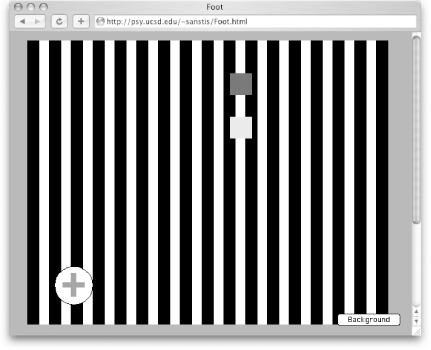Hack29.Turn Gliding Blocks into Stepping Feet
|
Hack 29. Turn Gliding Blocks into Stepping Feet
Motion detection uses contrast information first, not color. The moral of this story is that if you want people to see moving objects, make them brighter or darker than the background, not just a different color. Motion is important stuff for the brain. Information about movement gets routed from the eye to the visual cortexthe final destination for all visual informationalong its own pathway (you can take a tour round the visual system [Hack #13] ), the magnocellular pathway. (Like a lot of things in neuroscience, this sounds more technical than it is; magnocellular means "with large cells.") Color and form information travels along the parvocellular pathway (yup, "small cells") to the visual cortex, which means any motion has to be processed without access to that information. This functional division makes sense for a brain that wants to know immediately if there's a movement, and only secondly what exactly that moving something looks like. Problems arise only when movement processing is trying to figure out what sort of motion is occurring but the clues it needs are encoded in color and so not available. 2.18.1. In ActionStuart Anstis has constructed just such a problematic situation, and it leads to the nifty stepping feet illusion1 (http://psy.ucsd.edu/~sanstis/Foot.html; Shockwave). Blue and yellow blocks move smoothly in tandem from side to side. Click the Background button to bring up the striped background, and look again. It should look like Figure 2-24. Figure 2-24. The stepping feet illusion, with the striped background Even though they're still moving in the same direction, the blocks now appear to be alternately jerking forward, like little stepping feet. Like a lot of illusions, the effect is stronger in your peripheral vision; fix the center of your gaze at the cross off to the side and the stepping feet will be even clearer. 2.18.2. How It WorksThe easiest way to see why the stepping feet occur is to look at the same pattern, but without any colorthe yellow becomes white and the blue becomes black. Michael Bach's animation of stepping feet (http://www.michaelbach.de/ot/mot_feet_lin; Flash) allows you to remove the color with a click of the Color Off button. With no color, there's no illusion: the moving blocks appear like stepping feet even when you look straight at them. When the black (previously blue) block overlaps a black stripe, you can't see its leading edge so it isn't apparent that it's moving. Given no cues, your motion processing centers assume no movement. Then as the black block begins to move over a white stripe, you can suddenly see the leading edge again, and it's moved from where you brain had thought it was. That's when you see the block apparently jump forward and then move normallyat least until it overlaps the black stripe again. The same is true for the white (previously yellow) block over white stripes, only it moves when the black block looks still and vice versa. So that's what the blocks look like in black and white. Losing the movement information of the leading edge over one stripe in two makes the blocks look like stepping feet. And that's what the motion-sensitive and color-insensitive magnocellular pathway sees. The color information is added back in only later, reattached in the visual cortex after the motion has been computed. In the end, you're able to simultaneously see the stepping feet motion via one pathway and the colors via the other.
2.18.3. End Notes
2.18.4. See Also
|
|
EAN: N/A
Pages: 159
